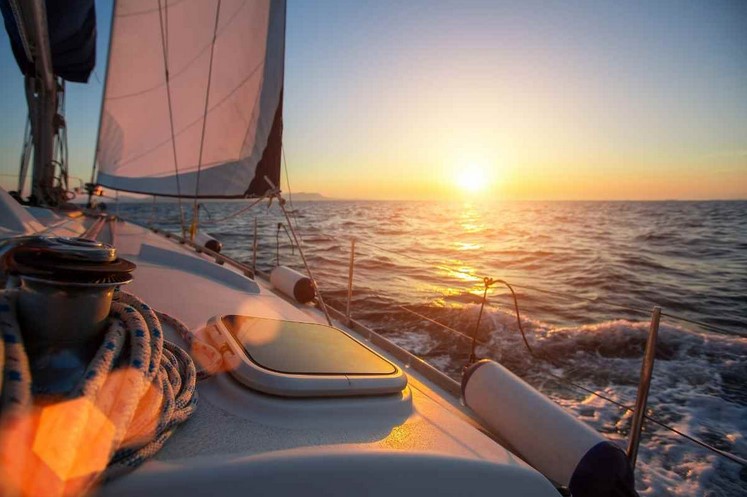How Far Can I Sail in a Day?

How long way you can sail in 24 hours? If you want to go on a sailing cruise, you want this sailing skill so that you can raise enough food, water, fuel, and sailing equipment for your sailing crew. You can use Voyage planning software or use these simple cruising tips.
What type of sailboat do you sail?
Sailing speed relies upon factors like weight (displacement), type of hull configuration (single or multi-hull), cruising ability of the boat in flat or choppy water, and how properly the boat treats her crew (pitching like a bronco, or slicing through the water like a warm knife through butter?). Use this guide to estimate your predicted speed over a day to help provision your small sailboat for cruising.
Displacement Cruising Sailboat Speed
Single hull, heavy cruising sailboats “displace” a positive amount of water. Imagine that you take a sailboat out of the water and the “water hole” where it is located is no longer filled with water. The amount of water contained in that gap would about equal the advertised displacement of the sailboat.
For example, If a cruising sailboat has an advertised displacement of 28,000 pounds, then when in the water, she displaces that equal amount of water. When sailing, she must push this quantity of water out of the way. That creates a lot of friction and limits the maximum speed that can be achieved.
To discern the maximum theoretical speed of a displacement sailboat, use this formula: 1.34 instances the square root of the waterline. Multiply the result by using 24 hours. This gives you the theoretical distance a displacement sailboat can cover every day.
Remember this will always be just theory. Plan for these days when the winds are super light and your pace will be slower than the theoretical displacement speed. On the other hand, you will have days when you run downwind where you will exceed the speed of the hull. The smart skipper will be ultra-conservative in his or her estimates. Some skippers of larger cruising boats would use a conservative estimate–like 150 miles per day–for cruising safety. That way, they can provision the boat with enough food, water, fuel, and sailing materials for their crew. This covers unexpected events such as greater light or heavy sailing climate or crew emergencies.
Catamaran and Trimaran Sailboat Speed
A multi-hull (more than one hull) sailboat – called a catamaran if it has two hulls, or a trimaran if it has three hulls – has most of its hull above the water. These boats are not slowed down as much by way of friction like their heavier displacement cruising cousins.
Large catamarans and trimarans often exceed the speed of the ship’s hull. Their speed over a cruising day depends on the sailing winds and seas. The cruising skipper may decide to sluggish the boat down while at sea (reefing or reducing sail) to keep away from crew fatigue and boost crew comfort.
As recommended above, be conservative in your estimates–even in gorgeous fast cruising sailboats. Just because a boat can go quickly all day long does not suggest that her crew can. It’s a lot of wear and tears on a short-handed sailing crew to sail quickly hour after hour. Some sailors of fast cruising boats like to plan for most of 150 nautical miles per day for provisioning and arrival time estimates.
Other Sailing Speed Averages
Dinghy sailboats and small catamarans (i.e. Hobie Cat) skim across the water and have simply a small amount of their hull beneath the water. This avoids most of the friction that cruisers encounter with heavy displacement. But, not like cruising sailboats, dinghies have no room for a lot of provisions–food, fuel, sailing gear, emergency sailing equipment–that you will want for sailing day after day when cruising.
So, unless you are that uncommon sailor who likes the smallest of accommodations, you will want to reserve sailing dinghies for day cruising trips. Daytime sailors go out for the day and return in the late afternoon or evening. Plan your sailing so that you have plenty of time to make it returned before darkness (unless you like sailing after dark–nothing quite like it!).
One plan would be to sail upwind or up current, beating or close achieving through most of the day. When it’s time to head back, you can then fall off to a comfy broad reach or run. lower back to your marina or boat ramp. That way, you avoid a lot of hard tacking towards the wind to make it back home.
Learn to sail with confidence when you understand how to estimate how far you can sail in a day. Use these simple cruising tips to help format and provision your next sailboat cruise–wherever in the world you choose to go sailing!






